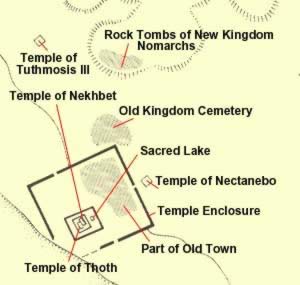The Temples of Thoth and Nekhbet at el-Kab
by Jimmy Dunn writing as Mark Andrews

El-Kab is perhaps most famous for its many splendid tombs, but there are also a number of temple ruins in the area. The main temple complex at el-Kab within the massive mudbrick wall that encompassed at least part of the ancient town, contains many different structures and is difficult to understand without a ground plan. In fact, there appears to be little serious investigation of this complex. These structures are built against and into each other. This region was sacred to the goddess Nekhbet, "She of Nekhen", who became the tutelary goddess of Upper Egypt while Wadjit was her counterpart in Lower Egypt.
It is probable that a simple temple structure was present at el-Kab from the Early Dynastic Period, and certainly Middle Kingdom rulers built here, but the current remains date from the New Kingdom on. The largest part of the main temple complex at el-Kab was dedicated to Nekhbet but this temple was attached to an older temple of Thoth. Many reused blocks from the Middle and New Kingdom can be seen in both temples. These structures are on the typical plan of the New Kingdom cult temple, with an open courtyard including a portico, a hypostyle hall, pronaos and three contiguous sanctuaries. Surrounding them are various subsidiary structures, including a Roman era temple.

The construction of the Temple of Thoth was begun in the 18th Dynasty under the direction of Amenhotep II. A pylon of Ramesses II forms the entrance fronting the temple of Thoth. Beyond the pylon, the open courtyard has two porticoes each with four columns that flank the processional way. This courtyard gives way to a small, six column hypostyle hall that precedes the pronaos, a small transverse hall with only two columns Beyond the pronaos is the triple sanctuaries.

The longer temple, dedicated to Nekhebet, adjoining the temple of Thoth on the northeast was also completed in stages, mostly during the Late Period's 29th and 30th Dynasties reigns of Hakoris and Nectanebo I and II, though it was probably initiated during the 25th Dynasty by Tahraqa with Psammetichus I adding to it in the 26th Dynasty upon even earlier remains. In this temple the walls of the forecourt were originally in line with those of the hypostyle hall in the adjacent temple of Thoth, but when this temple was enlarged eastward, it assumed an unsymmetrical plan.
In order to reach the courtyard, one passes through a set of small pylons. Within, there is actually an inner and outer courtyard, with the inner having two columns. Through a pylon with an interesting drainage system, this smaller, original courtyard gives access to an unsymmetrical hypostyle hall with two rows of four columns to the west, and four rows of four columns to the east. This hall was apparently built by Hakoris. Further east are two small chambers and one very small chamber. To the north of the hypostyle hall, a center entrance leads to the pronaos while to the left and right, entrances give way to a number of other annexes, some with columns. The pronaos itself has two pillars, and beyond this room, three doors lead to the triple sanctuaries, of which the center extends deeper than those to the left and right. A small space behind the left and right sanctuaries separated by the extended length of the central sanctuary are referred to as the "crypts of Psammetichus I.
Just to the east of the Temple of Nekhbet there is a small sacred lake.
To the south of this part of the temple complex lies a birthhouse containing a chamber with six columns, and further south is an arrangement of structures including pylons and a kiosk of Nectanebo I. This kiosk and pylon represented the entrance way through the send temple enclosure wall. Just to the east of the main pylon entrance is another opening called the "Lion Gate" Still further south, there are also the remains of a small Roman temple. It is abutted up against the outer enclosure wall. It s entrance is commonly referred to as the gate of Nectanebo I.
References:
| Title | Author | Date | Publisher | Reference Number |
| Atlas of Ancient Egypt | Baines, John; Malek, Jaromir | 1980 | Les Livres De France | None Stated |
| Complete Temples of Ancient Egypt, The | Wilkinson, Richard H. | 2000 | Thames and Hudson, Ltd | ISBN 0-500-05100-3 |
| Dictionary of Ancient Egypt, The | Shaw, Ian; Nicholson, Paul | 1995 | Harry N. Abrams, Inc., Publishers | ISBN 0-8109-3225-3 |
| History of Ancient Egypt, A | Grimal, Nicolas | 1988 | Blackwell | None Stated |
| History of Egyptian Architecture, A (The Empire (the New Kingdom) From the Eighteenth Dynasty to the End of the Twentieth Dynasty 1580-1085 B.C. | Badawy, Alexander | 1968 | University of California Press | LCCC A5-4746 |
| Oxford History of Ancient Egypt, The | Shaw, Ian | 2000 | Oxford University Press | ISBN 0-19-815034-2 |

